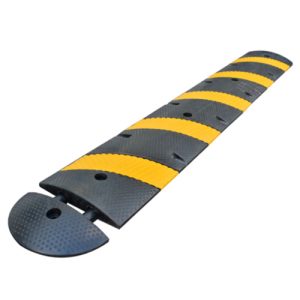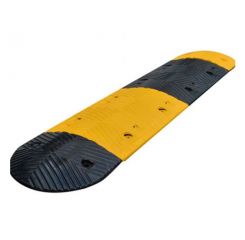Many cities and states have their own policies and regulations regarding the use of Speed Bumps. In general, they require that the speed of cars traveling through the area is less than 35 miles per hour. Before speed bumps can be installed, the governing body must give permission.
To find out what type of speed bump is right for your area, contact us. We can also advise you on your best options for traffic calming. We can even install these for you.
Types of speed bumps
There are two main types of speed bumps. The first type is called the Speed Bump, and it is the most severe of the two. The bump is typically one foot wide and three to four inches high, and traveling over it can cause serious suspension damage to vehicles.
Fortunately, this type of speed bump is rare and has been replaced by the Hump, which combines a wider construction with a less severe incline. The Hump replaces Speed Bumps as a standard type of road hazard, but still fulfills its core function.
The second type of speed bumps are known as Dynamic Speed Bumps. These devices sense a vehicle’s speed and slow it down accordingly. Dynamic speed bumps are available that sense vehicle speed and automatically increase their height.
If you install one, make sure it is visible to drivers. And always remember to read the signs posted near the humps. They can make a world of difference! It is worth taking the time to understand how they work, so you can choose the right one for your property!
| SKU | Description | Length | Height | Width | Weight |
|---|---|---|---|---|---|
| SB206FT | 6 Ft Speed Bump (1) 6′ Section With no End Caps | 72″ | 2″ | 12″ | 48.40 |
| SB207FT | 7 Ft Speed Bump (1) 6′ Section + (2) End Caps | 86″ | 2″ | 12″ | 55.40 |
| SB213FT | Single Lane 12 Ft Speed Bump (2) 6′ Section With no End Caps | 144″ | 2″ | 12″ | 96.80 |
| SB219FT | Double lane 19 Ft Speed Bump (3) 6′ Section + (2) End Caps | 230″ | 2″ | 12″ | 152.20 |
| SB225FT | 25 Ft Speed Bump (4) 6′ Section + (2) End Caps | 302″ | 2″ | 12″ | 200.60 |
| SB2ECAP | End cap | 7′ | 2′ | 12′ | 3.50 |
| SKU | Description | Length | Height | Width | Weight |
|---|---|---|---|---|---|
| SB3039I | 39″ Speed Bump (1) 39″ Section With no End Caps | 39″ | 2″ | 13.7″ | 36.20 |
| SB3117I | 117″ Single Lane Speed Bump (3) 39″ Sections With no End Caps | 117″ | 2″ | 13.7″ | 108.60 |
| SB3137I | 137″ Single Lane Speed Bump (3) 39″ Sections + (2) End Caps | 137″ | 2″ | 13.7″ | 124.20 |
| SB3234I | 234″ Double lane Speed Bump (6) 39″ Sections With no End Caps | 234″ | 2″ | 13.7″ | 217.20 |
| SB3254I-2 | 254″ Double Lane Speed Bump (6) 39″ Sections + (2) End Caps | 254″ | 2″ | 13.7″ | 232.80 |
| SB3ECAP-2 | End cap | 10″ | 2″ | 13.7″ | 7.80 |
| SKU | Description | Length | Height | Width | Weight |
|---|---|---|---|---|---|
| SH1018I | 18.75″ Speed Bump (1) 18.75″ Section with no End Caps | 18.75″ | 1.25″ | 2″ | 22.20 |
| SH1112I | 112.5″ Single Lane Speed Bump (6) 18.75″ Sections with no End Caps | 112.5″ | 1.25″ | 2″ | 133.20 |
| SH1128I | 10 Ft Single Lane Speed Bump (6) 18.75″ Sections + (2) End Caps | 128.5 | 1.25″ | 2″ | 148.80 |
| SH1225I | 225″ Double Lane Speed Bump (12) 18.75″ Sections with no End Caps | 225″ | 1.25″ | 2″ | 266.40 |
| SH1241I | 20 Ft Double Lane Speed Bump (12) 18.75″ Sections + (2) End Caps | 241″ | 1.25″ | 2″ | 282.00 |
| SH1ECAL | LEFT End Cap | 8″ | 1.25″ | 2′ | 7.80 |
| SH1ECAR | RIGHT End Cap | 8″ | 1.25″ | 2′ | 7.80 |
| SKU | Description | Length | Height | Width | Weight |
|---|---|---|---|---|---|
| SH2019I | 19.75″ Speed Bump (1) 19.75″ Section With no End Caps | 19.75″ | 2″ | 3″ | 48.00 |
| SH2121I | 10 Ft Single Lane Speed Bump (5) 19.75″ Sections + (2) End Caps | 121.75″ | 2″ | 3″ | 273.00 |
| SH2240I | 20 Ft Double Lane Speed Bump (11) 19.75″ + (2) End Caps | 240″ | 2″ | 3″ | 561.00 |
| SH2ECAL | LEFT End cap | 11.5″ | 2″ | 3′ | 16.00 |
| SH2ECAR | RIGHT End cap | 11.5″ | 2″ | 3′ | 16.00 |
Cost-effective options in speed bumps
A good rubber speed bump is a more cost-effective option than alternatives. It is durable, weather-resistant, and easier to install than a concrete one. It is also less invasive to the landscape, so you can remove it in the winter to prevent damage caused by snowplows.
The height of rubber speed bumps is generally three to four inches. The distance that traffic crosses the speed bump is about one foot. A speed bump can be temporary or permanent, depending on its placement.
The judicial system has yet to rule on whether or not speed bumps are permissible, but they have been used to limit the number of accidents and injuries to pedestrians. However, in the United States, courts have found that speed bumps are an inherent danger.
In a recent case, the Mississippi Supreme Court found that speed bumps are an unavoidable danger. In addition, there are at least two unpublished Connecticut court decisions on the topic.
These speed humps are designed to reduce traffic speed from a maximum of 25 mph to a slow, safe rate of two to ten miles per hour. They are most effective in areas with light vehicle traffic and low pedestrian activity.
Because the humps are higher, vehicles passing over them will slow down abruptly. Whether they are used for residential or commercial areas, they must be placed with caution to avoid causing damage to vehicles traveling at normal speed.
6′ Economy Recycled Rubber Heavy Duty Speed Bump
Recycled Rubber Speed Hump – Yellow / Black Single Lane or Double Lane
Premium Reclycled Rubber Safety-Striped Speed Hump – Reflective Rubber
Heavy Duty Rubber Speed Hump – Yellow / Black – Low Profile Speed Bump
- competitive Speed bumps
- reasonably priced Speed bumps
- moderately priced Speed bumps
- keenly priced Speed bumps
- budget Speed bumps
- economy Speed bumps
- cheap and cheerful Speed bumps
- bargain Speed bumps






